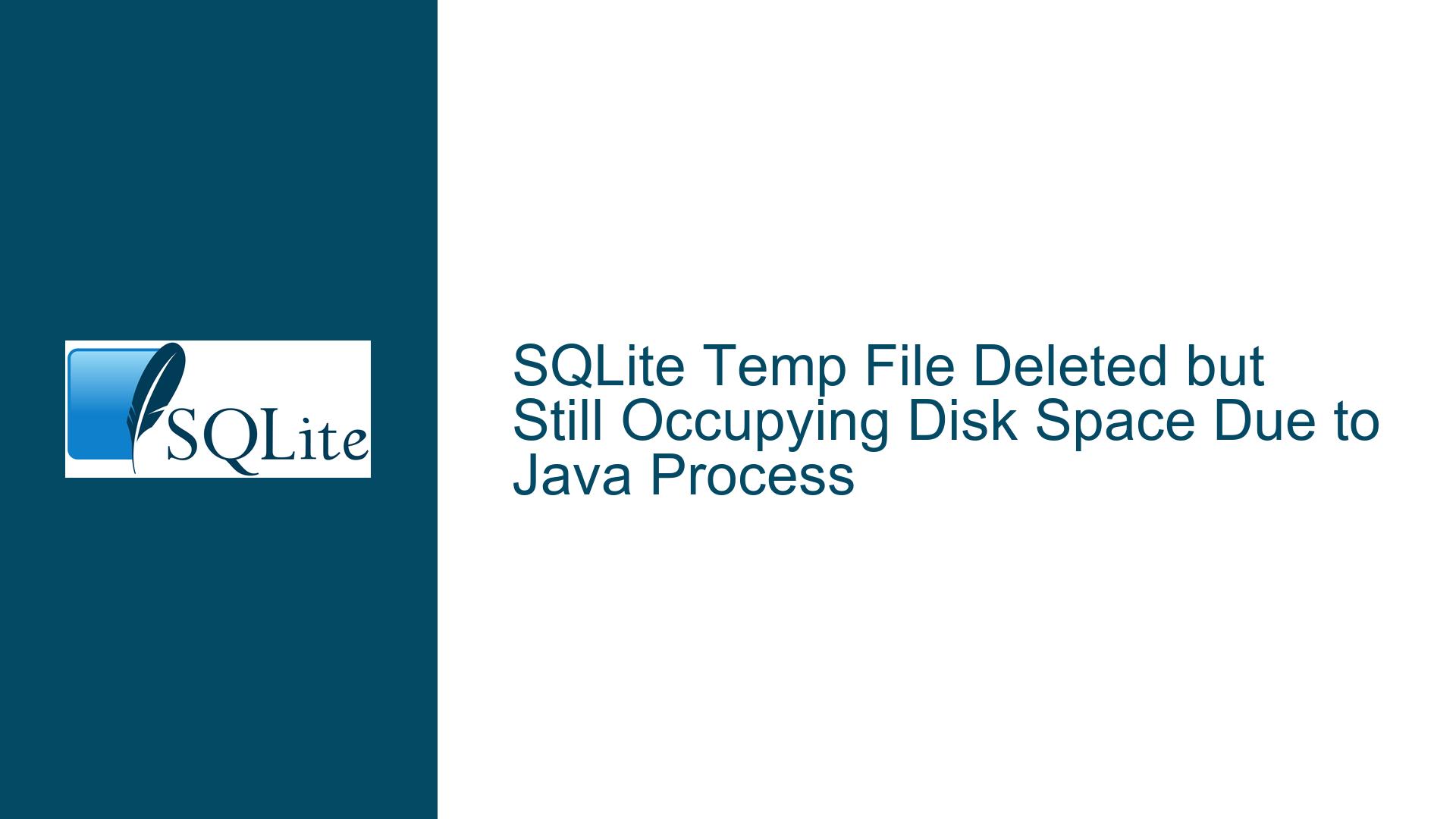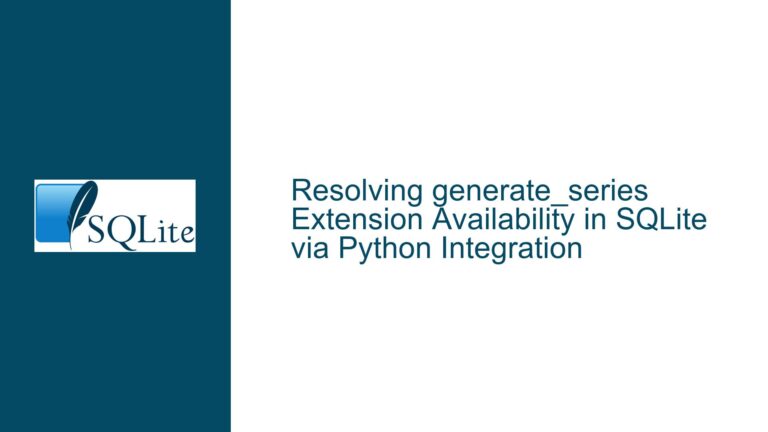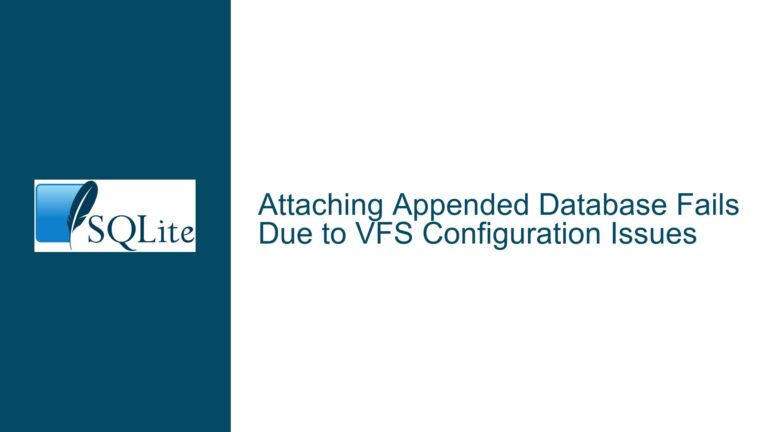SQLite Temp File Deleted but Still Occupying Disk Space Due to Java Process
SQLite Temp File Marked as Deleted but Retained by Java Process
The core issue revolves around SQLite temporary files that are marked as deleted but continue to occupy disk space because they are still held open by a Java process. This behavior is observed even after the SQLite database connection is explicitly closed. The temporary file, which is created during database operations, is not fully released by the operating system because the Java process retains an open file descriptor to it. This results in the file being listed as "deleted" in tools like lsof, yet it continues to consume disk space.
The problem is particularly problematic in environments where disk space is limited or where temporary files are frequently created and deleted. The issue manifests when SQLite is used in conjunction with the SQLite-JDBC driver, which bridges Java applications with SQLite databases. The temporary file in question is typically created in the directory specified by the temp_store_directory pragma, and its persistence suggests a misalignment between the SQLite-JDBC driver’s resource management and the operating system’s file handling mechanisms.
The behavior is further complicated by the fact that the Java process appears to retain the file descriptor even after the SQLite connection is closed. This indicates that the issue may not be directly related to SQLite itself but rather to how the SQLite-JDBC driver interacts with the underlying operating system and SQLite’s temporary file management.
Interrupted File Descriptor Release in SQLite-JDBC Driver
The root cause of this issue lies in the interaction between the SQLite-JDBC driver and the operating system’s file handling mechanisms. When a temporary file is created by SQLite, it is managed by the operating system, which assigns a file descriptor to it. Under normal circumstances, when the SQLite connection is closed, the file descriptor should be released, and the temporary file should be deleted. However, in this case, the Java process retains the file descriptor, preventing the operating system from fully releasing the file.
One possible explanation is that the SQLite-JDBC driver does not properly close the file descriptors associated with temporary files. This could be due to a bug in the driver or an oversight in its resource management logic. Another possibility is that the Java process forks subprocesses that inherit the open file descriptors, as suggested in the discussion. This would result in the temporary file being retained even after the parent process has closed the SQLite connection.
Additionally, the issue may be exacerbated by the use of the temp_store_directory pragma, which directs SQLite to store temporary files in a specific directory. If the directory is shared among multiple processes or threads, it could lead to contention and improper handling of temporary files. The fact that the temporary file is associated with a transaction that is still active, as indicated by the changing SIZE/OFF value in the lsof output, further supports the idea that the issue is related to incomplete transactions or improperly released resources.
Resolving SQLite Temp File Retention with PRAGMA Settings and JDBC Driver Updates
To address this issue, several steps can be taken to ensure that temporary files are properly released and do not continue to occupy disk space. The first step is to verify that the SQLite-JDBC driver is up to date, as the issue may have been resolved in a newer version. If the problem persists, the following troubleshooting steps and solutions can be implemented:
Update the SQLite-JDBC Driver: Ensure that the latest version of the SQLite-JDBC driver is being used. The issue may have been fixed in a recent update, and upgrading the driver could resolve the problem without further intervention.
Review Resource Management in Java Code: Carefully review the Java code to ensure that all SQLite connections are properly closed and that no file descriptors are inadvertently retained. This includes checking for any subprocesses that may inherit open file descriptors and ensuring that they are properly managed.
Modify PRAGMA Settings: Adjust the
temp_store_directorypragma to use a different directory for temporary files. This can help isolate the issue and prevent contention among multiple processes or threads. Additionally, consider using thejournal_modepragma to change the journaling mode, which can affect how temporary files are managed.Monitor File Descriptors with
lsof: Use thelsofcommand to monitor file descriptors and identify any that are being retained unnecessarily. This can help pinpoint the source of the issue and ensure that all file descriptors are properly released.Implement a File Cleanup Routine: Develop a routine that periodically checks for and deletes any temporary files that are marked as deleted but still occupy disk space. This can be done using a script or a scheduled task that runs at regular intervals.
Consult the SQLite-JDBC Issue Tracker: If the issue persists, consult the SQLite-JDBC issue tracker for any related reports or fixes. The issue may have been reported by other users, and there may be a workaround or fix available.
By following these steps, the issue of SQLite temporary files being marked as deleted but still occupying disk space can be effectively resolved. It is important to approach the problem systematically, starting with the simplest solutions and progressing to more complex ones if necessary. Ensuring that the SQLite-JDBC driver is up to date and that all resources are properly managed is key to preventing this issue from recurring.
| Step | Action | Expected Outcome |
|---|---|---|
| 1 | Update SQLite-JDBC Driver | Resolve potential bugs in the driver |
| 2 | Review Java Code | Ensure proper closure of SQLite connections |
| 3 | Adjust PRAGMA Settings | Isolate temporary files and prevent contention |
| 4 | Monitor with lsof | Identify retained file descriptors |
| 5 | Implement Cleanup Routine | Periodically delete orphaned temporary files |
| 6 | Consult Issue Tracker | Find workarounds or fixes from the community |
In conclusion, the issue of SQLite temporary files being marked as deleted but still occupying disk space is a complex one that requires a thorough understanding of both SQLite and the SQLite-JDBC driver. By systematically addressing the potential causes and implementing the suggested solutions, the problem can be effectively mitigated, ensuring efficient use of disk space and proper resource management in Java applications using SQLite.






